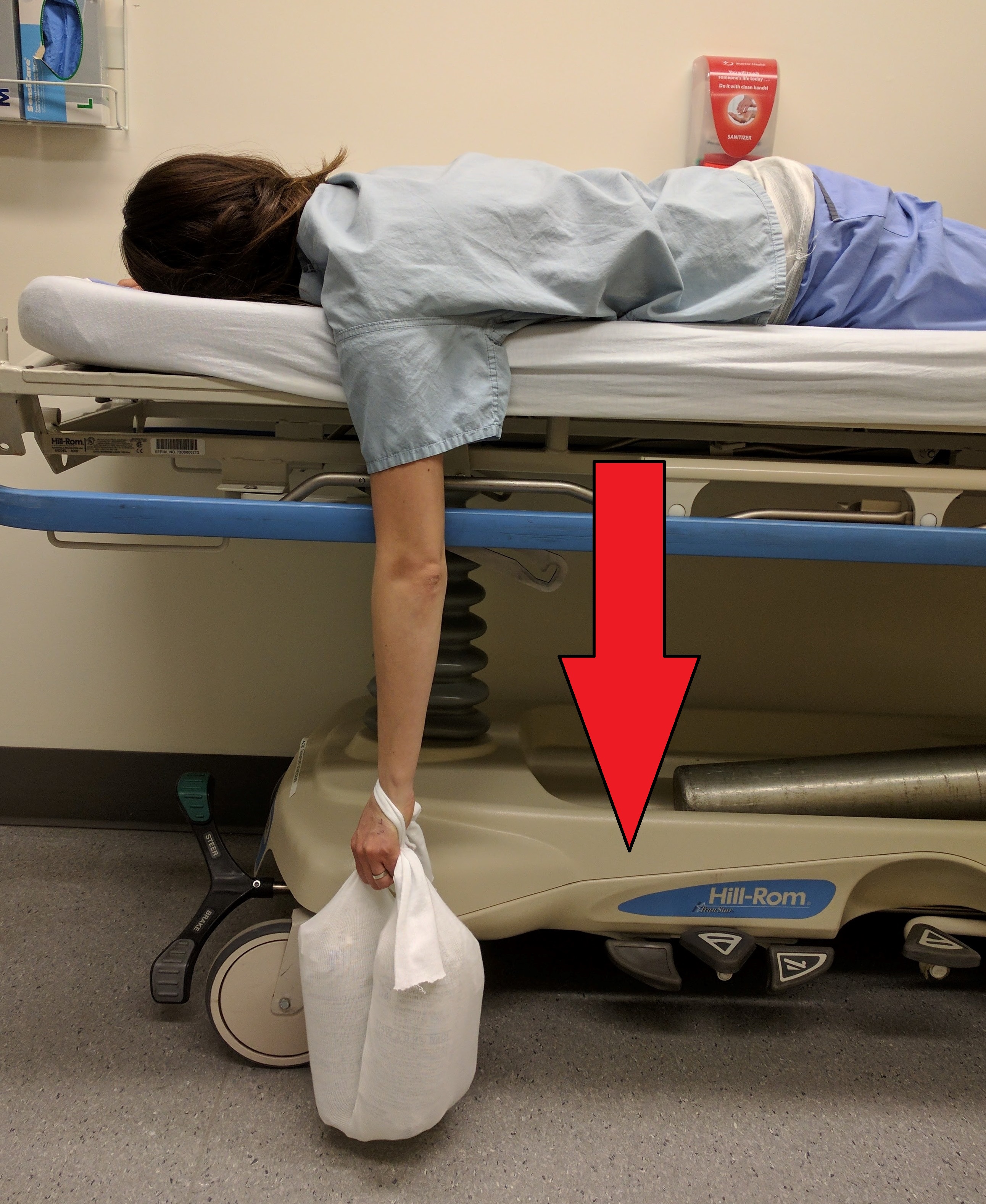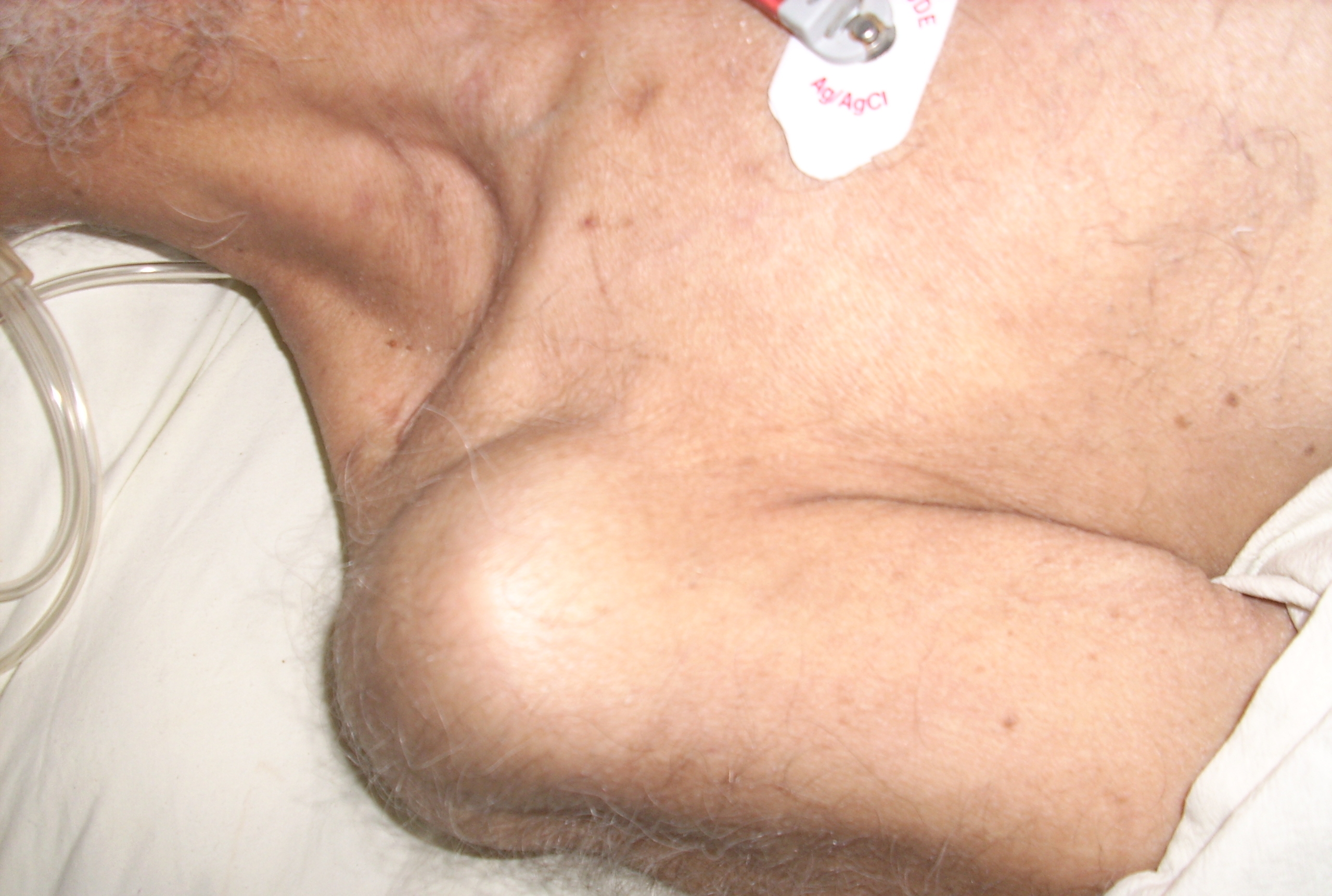|
Shoulder Reduction
Shoulder reduction is the process of returning the shoulder to its normal position following a shoulder dislocation. Normally, closed reduction, in which the relationship of bone and joint is manipulated externally without surgical intervention, is used. A variety of techniques exist, but some are preferred due to fewer complications or easier execution. In cases where closed reduction is not successful, open (surgical) reduction may be needed. X-rays are often used to confirm success and absence of associated fractures. The arm should be kept in a sling or immobilizer for several days, prior to supervised recovery of motion and strength. Various non-operative reduction techniques are employed. They have certain principles in common, including gentle in-line traction, reduction or abolition of muscle spasm, and gentle external rotation. They all strive to avoid inadvertent injury. Two of them, the Milch and Stimson techniques, have been compared in a randomized trial. Pain can be m ... [...More Info...] [...Related Items...] OR: [Wikipedia] [Google] [Baidu] |
Shoulder Dislocation
A dislocated shoulder is a condition in which the head of the humerus is detached from the shoulder joint. Symptoms include shoulder pain and instability. Complications may include a Bankart lesion, Hill-Sachs lesion, rotator cuff tear, or injury to the axillary nerve. A shoulder dislocation often occurs as a result of a fall onto an outstretched arm or onto the shoulder. Diagnosis is typically based on symptoms and confirmed by X-rays. They are classified as anterior, posterior, inferior, and superior with most being anterior. Treatment is by shoulder reduction which may be accomplished by a number of techniques. These include traction-countertraction, external rotation, scapular manipulation, and the Stimson technique. After reduction X-rays are recommended for verification. The arm may then be placed in a sling for a few weeks. Surgery may be recommended in those with recurrent dislocations. Not all patients require surgery following a shoulder dislocation. There is m ... [...More Info...] [...Related Items...] OR: [Wikipedia] [Google] [Baidu] |
Joint
A joint or articulation (or articular surface) is the connection made between bones, ossicles, or other hard structures in the body which link an animal's skeletal system into a functional whole.Saladin, Ken. Anatomy & Physiology. 7th ed. McGraw-Hill Connect. Webp.274/ref> They are constructed to allow for different degrees and types of movement. Some joints, such as the knee, elbow, and shoulder, are self-lubricating, almost frictionless, and are able to withstand compression and maintain heavy loads while still executing smooth and precise movements. Other joints such as sutures between the bones of the skull permit very little movement (only during birth) in order to protect the brain and the sense organs. The connection between a tooth and the jawbone is also called a joint, and is described as a fibrous joint known as a gomphosis. Joints are classified both structurally and functionally. Classification The number of joints depends on if sesamoids are included, age of the ... [...More Info...] [...Related Items...] OR: [Wikipedia] [Google] [Baidu] |
Complication (medicine)
A complication in medicine, or medical complication, is an unfavorable result of a disease, health condition, or treatment. Complications may adversely affect the prognosis, or outcome, of a disease. Complications generally involve a worsening in severity of disease or the development of new signs, symptoms, or pathological changes which may become widespread throughout the body and affect other organ systems. Thus, complications may lead to the development of new diseases resulting from a previously existing disease. Complications may also arise as a result of various treatments. The development of complications depends on a number of factors, including the degree of vulnerability, susceptibility, age, health status, and immune system condition. Knowledge of the most common and severe complications of a disease, procedure, or treatment allow for prevention and preparation for treatment if they should occur. Complications are not to be confused with sequelae, which are residual ... [...More Info...] [...Related Items...] OR: [Wikipedia] [Google] [Baidu] |
X-ray
An X-ray, or, much less commonly, X-radiation, is a penetrating form of high-energy electromagnetic radiation. Most X-rays have a wavelength ranging from 10 picometers to 10 nanometers, corresponding to frequencies in the range 30 petahertz to 30 exahertz ( to ) and energies in the range 145 eV to 124 keV. X-ray wavelengths are shorter than those of UV rays and typically longer than those of gamma rays. In many languages, X-radiation is referred to as Röntgen radiation, after the German scientist Wilhelm Conrad Röntgen, who discovered it on November 8, 1895. He named it ''X-radiation'' to signify an unknown type of radiation.Novelline, Robert (1997). ''Squire's Fundamentals of Radiology''. Harvard University Press. 5th edition. . Spellings of ''X-ray(s)'' in English include the variants ''x-ray(s)'', ''xray(s)'', and ''X ray(s)''. The most familiar use of X-rays is checking for fractures (broken bones), but X-rays are also used in other ways. ... [...More Info...] [...Related Items...] OR: [Wikipedia] [Google] [Baidu] |
Fracture
Fracture is the separation of an object or material into two or more pieces under the action of stress. The fracture of a solid usually occurs due to the development of certain displacement discontinuity surfaces within the solid. If a displacement develops perpendicular to the surface, it is called a normal tensile crack or simply a crack; if a displacement develops tangentially, it is called a shear crack, slip band or dislocation. Brittle fractures occur with no apparent deformation before fracture. Ductile fractures occur after visible deformation. Fracture strength, or breaking strength, is the stress when a specimen fails or fractures. The detailed understanding of how a fracture occurs and develops in materials is the object of fracture mechanics. Strength Fracture strength, also known as breaking strength, is the stress at which a specimen fails via fracture. This is usually determined for a given specimen by a tensile test, which charts the stress–strain cu ... [...More Info...] [...Related Items...] OR: [Wikipedia] [Google] [Baidu] |
Procedural Sedation And Analgesia
Procedural sedation and analgesia (PSA) is a technique in which a sedating/dissociative medication is given, usually along with an analgesic medication, in order to perform non-surgical procedures on a patient. The overall goal is to induce a decreased level of consciousness while maintaining the patient's ability to breathe on their own. Airway protective reflexes are not compromised by this process Walls, Ron M., MD; Hockberger, Robert S., MD; Gausche-Hill, Marianne, MD, FACEP, FAAP, FAEMS (2018). ''Rosen's Emergency Medicine: Concepts and Clinical Practice. Ninth Edition''. Elsevier. and therefore endotracheal intubation is not required. PSA is commonly used in the emergency department, in addition to the operating room. Medical uses This technique is often used in the emergency department for the performance of painful or uncomfortable procedures. Common purposes include: * laceration repair * setting fractures * draining abscesses * reducing dislocations * performing endoscop ... [...More Info...] [...Related Items...] OR: [Wikipedia] [Google] [Baidu] |
Lidocaine
Lidocaine, also known as lignocaine and sold under the brand name Xylocaine among others, is a local anesthetic of the amino amide type. It is also used to treat ventricular tachycardia. When used for local anaesthesia or in nerve blocks, lidocaine typically begins working within several minutes and lasts for half an hour to three hours. Lidocaine mixtures may also be applied directly to the skin or mucous membranes to numb the area. It is often used mixed with a small amount of adrenaline (epinephrine) to prolong its local effects and to decrease bleeding. If injected intravenously, it may cause cerebral effects such as confusion, changes in vision, numbness, tingling, and vomiting. It can cause low blood pressure and an irregular heart rate. There are concerns that injecting it into a joint can cause problems with the cartilage. It appears to be generally safe for use in pregnancy. A lower dose may be required in those with liver problems. It is generally safe to use in those ... [...More Info...] [...Related Items...] OR: [Wikipedia] [Google] [Baidu] |
Stimson2017
Stimson may refer to: * Charles Stimson (born 1963), American Pentagon official * Frederic Jesup Stimson (1855–1943), American diplomat * Gerry Stimson, British public health social scientist * Henry L. Stimson (1867–1950), American statesman * James Stimson (born 1943), American political scientist ** Mount Stimson, peak in Montana, named for Henry Stimson * Hugh M. Stimson (1931–2011), American sinologist * Julia Catherine Stimson (1881–1948), American nurse * Mark Stimson Mark Nicholas Stimson (born 27 December 1967) is an English former footballer and is currently manager of Hornchurch. He signed his first professional contract with Tottenham Hotspur in 1985, but was unable to gain a regular place in the team. I ... (born 1967), English former footballer * Miriam Michael Stimson (1913–2002), American nun and chemist * Rufus W. Stimson (1868–1947), American agricultural educator and college president {{surname ... [...More Info...] [...Related Items...] OR: [Wikipedia] [Google] [Baidu] |
Cunningham Technique Demonstration
Cunningham is a surname of Scottish origin, see Clan Cunningham. Notable people sharing this surname A–C *Aaron Cunningham (born 1986), American baseball player *Abe Cunningham, American drummer * Adrian Cunningham (born 1960), Australian archivist *Alan Cunningham, British Second World War general *Alexander Cunningham (1814–1893), British archaeologist, father of the Archaeological Survey of India *Alexander Cunningham, 1st Earl of Glencairn (1426–1488), a Scottish nobleman *Alexander Cunningham, 5th Earl of Glencairn (died 1574), a Scottish nobleman and covenanter *Alfred Austell Cunningham, American aviation pioneer * Allan Cunningham (other) or Allen Cunningham, several people *Andrew Cunningham, 1st Viscount Cunningham of Hyndhope, British Second World War admiral *Andrew Cunningham (other) or Andy Cunningham, several people *Archibald Cunningham (1879–1915), Scottish footballer *Bert Cunningham (1865–1962), American baseball player *Bertram C ... [...More Info...] [...Related Items...] OR: [Wikipedia] [Google] [Baidu] |
Cunningham Technique
Cunningham shoulder reduction was originally published in 2003 and is an anatomically based method of shoulder reduction that utilizes positioning (analgesic position), voluntary scapular retraction, and bicipital massage. It is designed for true anterior/subcoracoid glenohumeral dislocations in patients who can fully adduct their humerus. This is distinct from anteroinferior/subglenoid glenohumeral dislocations for which alternative techniques should be used. The method is one of several techniques used for shoulder reduction. Mechanism Shoulder dislocation is a common complication of upper limb trauma (arm pulled while in abduction or direct impact to shoulder) resulting with the humeral head sitting anteriorly out of the glenoid fossa. Technique is as follows: Step 1 Sit patient up (without slouching, towel or pillow down spine) and place into analgesic position. ‘Hold’- take control of the affected limb with a 'hold.' This is a firm steady downward hold (not a pull ... [...More Info...] [...Related Items...] OR: [Wikipedia] [Google] [Baidu] |






